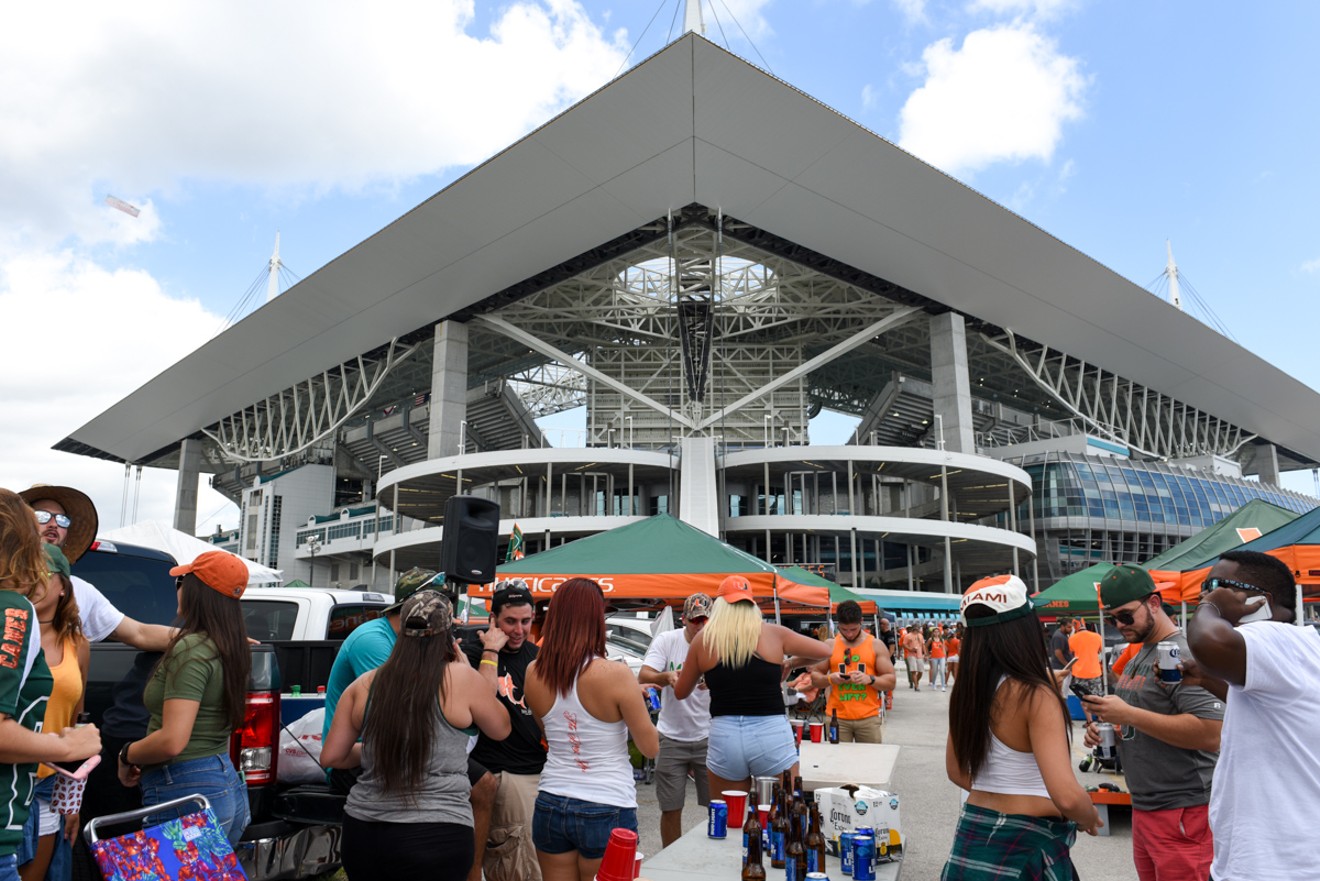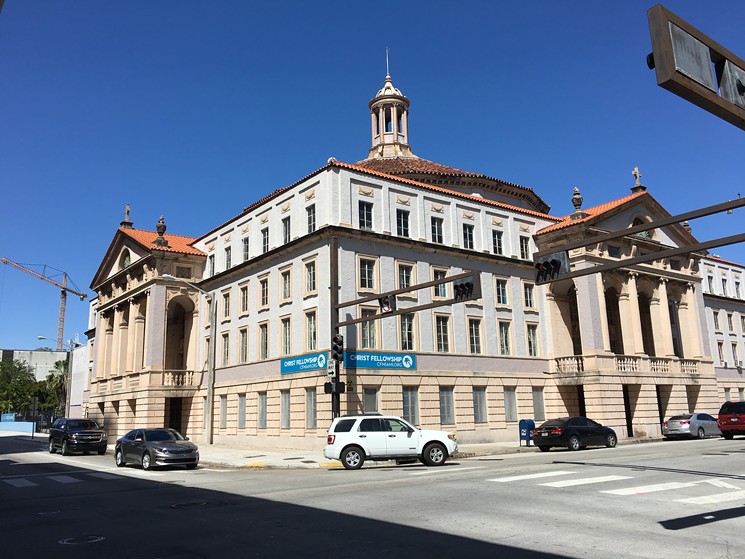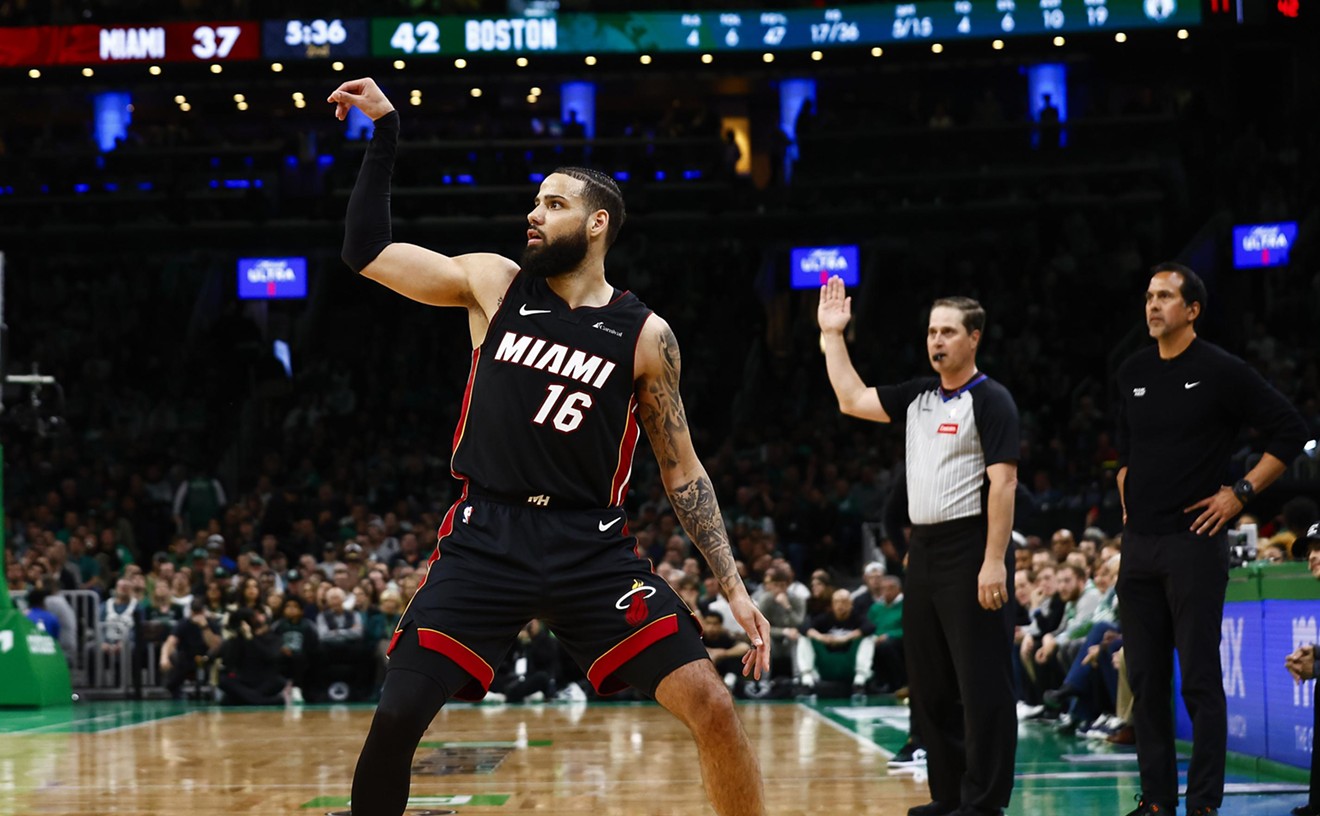The Ten Most Underrated Architectural Sites in Metro Miami
When tourists visit Miami, they expect to see three things: beaches, butts, and art deco buildings. Indeed, South Beach's gorgeous pastel hotels and restaurants have been South Florida's most iconic architecture since their construction in the city's 1920s golden age. Besides the Freedom Tower, American Airlines Arena, or perhaps the ubiquitous stark-white modernist mansion, nothing else lingers in the mind that's quite as suggestive of the Magic City.
July 25, 2017

Tailgaters outside the newly renovated at Hard Rock Stadium.
Photo by Michele Eve Sandberg
[
{
"name": "Air - MediumRectangle - Inline Content - Mobile Display Size",
"component": "19274298",
"insertPoint": "2",
"requiredCountToDisplay": "2"
},{
"name": "Editor Picks",
"component": "17482312",
"insertPoint": "4",
"requiredCountToDisplay": "1"
},{
"name": "Inline Links",
"component": "18711090",
"insertPoint": "8th",
"startingPoint": 8,
"requiredCountToDisplay": "7",
"maxInsertions": 25
},{
"name": "Air - MediumRectangle - Combo - Inline Content",
"component": "17482310",
"insertPoint": "8th",
"startingPoint": 8,
"requiredCountToDisplay": "7",
"maxInsertions": 25
},{
"name": "Inline Links",
"component": "18711090",
"insertPoint": "8th",
"startingPoint": 12,
"requiredCountToDisplay": "11",
"maxInsertions": 25
},{
"name": "Air - Leaderboard Tower - Combo - Inline Content",
"component": "17482313",
"insertPoint": "8th",
"startingPoint": 12,
"requiredCountToDisplay": "11",
"maxInsertions": 25
}
]
When tourists visit Miami, they expect to see three things: beaches, butts, and art deco buildings. Indeed, South Beach's gorgeous pastel hotels and restaurants have been South Florida's most iconic architecture since their construction in the city's 1920s golden age. Besides the Freedom Tower, American Airlines Arena, or perhaps the ubiquitous stark-white modernist mansion, nothing else lingers in the mind that's quite as suggestive of the Magic City.
But there's more to architecture than its most famous buildings. Across the area, a vast array of underappreciated designs come in a variety of styles: brutalist libraries, Mediterranean manors, Spanish colonial churches, and more.
Here are ten of our favorite hidden gems and underrated highlights of Miami architecture:
1. Central Baptist Church. Many cities contain grand old churches like Central Baptist, but it’s surprising to find one right in the middle of the skyscraper jungle of downtown Miami. Although it’s adjacent to the College North Metromover station, this building is best appreciated from another stop: Park West. From the train platform, with the Freedom Tower to the left, the building’s classical façade and red-orange dome are just barely visible, a vibrant island in a sea of concrete and steel. It’s like our own little Florence Basilica. It's just a shame we had to spoil the view. 500 NE First Ave., Miami.
2. Broward County Main Library. The grandiose, concrete-heavy style of brutalism has been hated and loved in equal measure since emerging in the 20th Century. Fans love its monumental timelessness and raw beauty, while detractors think it’s dehumanizing. The Broward County Main Library, designed in the '80s by Robert Gatje of the legendary Marcel Breuer firm, shows how to do the style right. An exterior clad in coral rock and foliage offsets the intensity of the concrete, and its wide-open, five-story atrium lets in light and makes the cavernous space warm and welcoming. Brutalism was meant for grand public spaces like this. 100 S. Andrews Ave., Fort Lauderdale.
3. Hard Rock Stadium. If you use the Turnpike to commute to Miami from Broward, you likely pass the Miami Dolphins' home stadium. Until last year, it wasn’t much to look at, with spiral ramps and video screens suggesting a big concrete toilet. But after a $500 million renovation last year, the newly christened, white-canopied Hard Rock Stadium is not only a great venue for sports but also a remarkable, stylish building, comparable to the bone-white skeletal structures of celebrated Spanish architect Santiago Calatrava or even Frank Gehry's New World Center in Miami Beach. With spires that rise like ship masts over the North Miami-Dade landscape, the flat, square roof looks like it could be its own heavenly playing field. 347 Don Shula Dr., Miami Gardens.
4. Wolfsonian-FIU. Ever find yourself walking along Washington Avenue past the Wolfsonian and wonder, Why does that warehouse have such an ornate façade? OK, you probably didn’t use those exact words, but it's no surprise if the structure turned your head. The building now housing Florida International University’s design and decorative arts museum was built in 1927 as the Washington Storage Company, a facility for rich snowbirds to store their paintings and furniture — like a Public Storage, but not public. When philanthropist Micky Wolfson converted the space, he preserved the exterior sandstone carvings, and now anyone can view art that might once have been hidden in vaults. 1001 Washington Ave., Miami Beach.
5. Temple Emanu-El. There’s no lack of beautiful old churches in Miami, but what about synagogues? South Florida is home to the second-largest Jewish population in the United States, after all, and there’s no more visible reminder than Temple Emanu-El. Modeled after the Great Synagogue of Oran, Algeria (which is now a mosque), Emanu-El, with its impressive dome and columned, arabesque façade, is a landmark of Jewish history and presence in Miami Beach. Plus, it’s across the street from the Fillmore Miami Beach and the New World Center, meaning you can take in a show right after services or appreciate its charms while sitting outside for a free concert. 1701 Washington Ave., Miami Beach.
6. Coral Gables City Hall. It’s easy to make jokes about Coral Gables. If you judge the "City Beautiful" simply from headlines, it might seem like a town full of rich, snooty jerks with a strange, irrational hatred of pickup trucks and, lately, medical marijuana. But one thing they do have is taste. Just look at their immaculate city hall, an ornate, Mediterranean-revival structure complete with clock tower and limestone Corinthian colonnade. It’s an undeniably lovely building. Perhaps the city’s tendency to pass ridiculous laws comes from city hall making them feel less like public servants and more like royalty. 405 Biltmore Way, Coral Gables.
7. Pump House. Arguably the most gorgeous structure ever designed for waterworks, the coral-rock pump house on Miami's Upper Eastside was built during the city's 1920s real estate boom to supply water to residents of the new suburb of Bay Shore, now known as Morningside. After the city annexed the town and abandoned the facility, it traded owners — teachers, doctors, perhaps a serial killer, and even a cult leader — throughout the 20th Century and fell into deep disrepair until finally being renovated by hairstylist J.B. Kilpatrick in 2006. The picturesque house is now home to restaurateur Mark Soyka’s Café Roval, which New Times voted Miami’s Best Romantic Restaurant this year. 5808 NE Fourth Ct., Miami.
8. Deering Estate. When it comes to glorious old mansions in Miami, James Deering’s Vizcaya tends to get all the attention. But James wasn’t the only Deering to stake a claim in Dade County: His older brother Charles built an estate farther south in Palmetto Bay. He constructed the stunning Stone House, a Mediterranean villa straight out of Romeo and Juliet, to store an art collection including works by Rembrandt and El Greco. The waterfront property also boasts a three-story cottage and one of the only prehistoric burial mounds in the county. 16701 SW 72nd Ave., Palmetto Bay.
9. Fowey Rocks Light. If you want to visit this site, you might need to get a little wet. Seven miles southeast of Key Biscayne, past the eastern edge of the bay, stands this conical lighthouse, built in 1878 and automated in 1975. It’s certainly not the prettiest structure on this list — it wasn’t much to look at in 1935 after its lower deck was washed away in a hurricane — but the stark, skeletal building has a creepy, transfixing appeal. With a shipwrecked steamer sitting 200 yards below the light, the place might even be haunted.
10. Coral Gables Congregational Church. Wait a second, are we in Coral Gables or San Diego? This church is such a fine example of Spanish colonial architecture, with remarkable porcelain-white carvings above the entrance and on the bell tower, that seeing it in person might convince you it’s a Southern California mission. The Gables isn't lacking in historic churches — there’s also the Church of the Little Flower — but the Congregational Church might be its most stylistically distinctive. Plus, its interior is equally stunning, with rich wooden supports and tile floors that’ll take you straight to the climax of Vertigo, Face/Off, or maybe even The Godfather. 3010 De Soto Blvd., Coral Gables.
BEFORE YOU GO...
Can you help us continue to share our stories? Since the beginning, Miami New Times has been defined as the free, independent voice of Miami — and we'd like to keep it that way. Our members allow us to continue offering readers access to our incisive coverage of local news, food, and culture with no paywalls.
Can you help us continue to share our stories? Since the beginning, Miami New Times has been defined as the free, independent voice of Miami — and we'd like to keep it that way. Our members allow us to continue offering readers access to our incisive coverage of local news, food, and culture with no paywalls.
Douglas Markowitz has covered art and music in South Florida for nearly a decade, with stories published by Resident Advisor, the Miami Herald, the Sun Sentinel, Artburst, Burnaway, and principally the Miami New Times, where he interned in 2017. In 2023 he was named a finalist for the Knight-Esserman Journalism Award. He is a University of North Florida graduate and former culture editor at the Phoenix New Times.
Contact:
Douglas Markowitz
Follow:
Twitter: @dougmarkowitz


Newsletter Sign Up
Enter your name, zip code, and email
I agree to the Terms of Service and
Privacy Policy
Sign up for our newsletters
Get the latest
News,
free stuff and more!
Trending
Use of this website constitutes acceptance of our
terms of use,
our cookies policy, and our
privacy policy
The Miami New Times may earn a portion of sales from products & services purchased through links on our site from our
affiliate partners.
©2024
Miami New Times, LLC. All rights reserved.
Do Not Sell or Share My Information
Do Not Sell or Share My Information



















